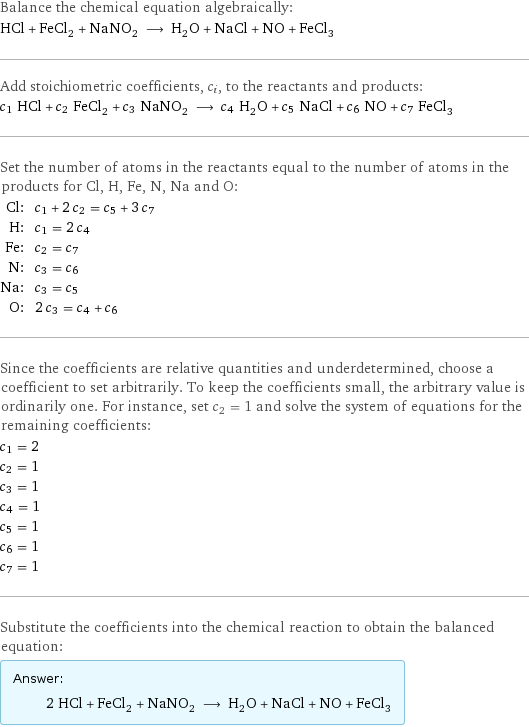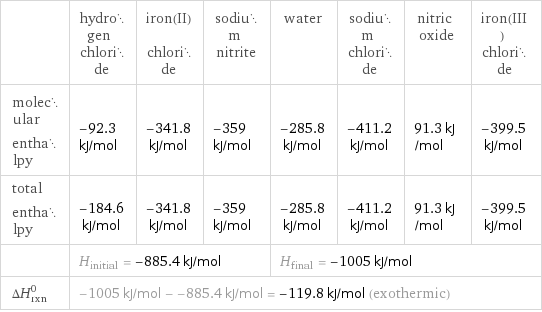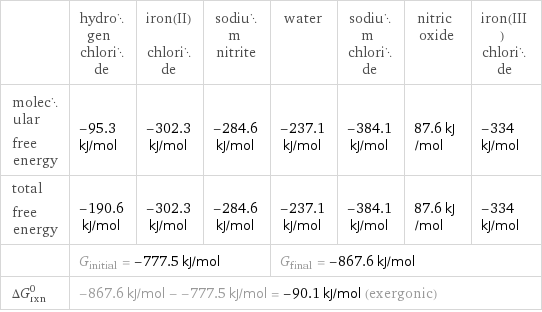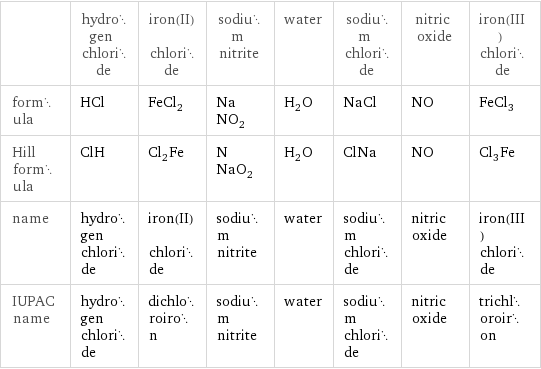Input interpretation

HCl hydrogen chloride + FeCl_2 iron(II) chloride + NaNO_2 sodium nitrite ⟶ H_2O water + NaCl sodium chloride + NO nitric oxide + FeCl_3 iron(III) chloride
Balanced equation

Balance the chemical equation algebraically: HCl + FeCl_2 + NaNO_2 ⟶ H_2O + NaCl + NO + FeCl_3 Add stoichiometric coefficients, c_i, to the reactants and products: c_1 HCl + c_2 FeCl_2 + c_3 NaNO_2 ⟶ c_4 H_2O + c_5 NaCl + c_6 NO + c_7 FeCl_3 Set the number of atoms in the reactants equal to the number of atoms in the products for Cl, H, Fe, N, Na and O: Cl: | c_1 + 2 c_2 = c_5 + 3 c_7 H: | c_1 = 2 c_4 Fe: | c_2 = c_7 N: | c_3 = c_6 Na: | c_3 = c_5 O: | 2 c_3 = c_4 + c_6 Since the coefficients are relative quantities and underdetermined, choose a coefficient to set arbitrarily. To keep the coefficients small, the arbitrary value is ordinarily one. For instance, set c_2 = 1 and solve the system of equations for the remaining coefficients: c_1 = 2 c_2 = 1 c_3 = 1 c_4 = 1 c_5 = 1 c_6 = 1 c_7 = 1 Substitute the coefficients into the chemical reaction to obtain the balanced equation: Answer: | | 2 HCl + FeCl_2 + NaNO_2 ⟶ H_2O + NaCl + NO + FeCl_3
Structures

+ + ⟶ + + +
Names

hydrogen chloride + iron(II) chloride + sodium nitrite ⟶ water + sodium chloride + nitric oxide + iron(III) chloride
Reaction thermodynamics
Enthalpy

| hydrogen chloride | iron(II) chloride | sodium nitrite | water | sodium chloride | nitric oxide | iron(III) chloride molecular enthalpy | -92.3 kJ/mol | -341.8 kJ/mol | -359 kJ/mol | -285.8 kJ/mol | -411.2 kJ/mol | 91.3 kJ/mol | -399.5 kJ/mol total enthalpy | -184.6 kJ/mol | -341.8 kJ/mol | -359 kJ/mol | -285.8 kJ/mol | -411.2 kJ/mol | 91.3 kJ/mol | -399.5 kJ/mol | H_initial = -885.4 kJ/mol | | | H_final = -1005 kJ/mol | | | ΔH_rxn^0 | -1005 kJ/mol - -885.4 kJ/mol = -119.8 kJ/mol (exothermic) | | | | | |
Gibbs free energy

| hydrogen chloride | iron(II) chloride | sodium nitrite | water | sodium chloride | nitric oxide | iron(III) chloride molecular free energy | -95.3 kJ/mol | -302.3 kJ/mol | -284.6 kJ/mol | -237.1 kJ/mol | -384.1 kJ/mol | 87.6 kJ/mol | -334 kJ/mol total free energy | -190.6 kJ/mol | -302.3 kJ/mol | -284.6 kJ/mol | -237.1 kJ/mol | -384.1 kJ/mol | 87.6 kJ/mol | -334 kJ/mol | G_initial = -777.5 kJ/mol | | | G_final = -867.6 kJ/mol | | | ΔG_rxn^0 | -867.6 kJ/mol - -777.5 kJ/mol = -90.1 kJ/mol (exergonic) | | | | | |
Equilibrium constant
![Construct the equilibrium constant, K, expression for: HCl + FeCl_2 + NaNO_2 ⟶ H_2O + NaCl + NO + FeCl_3 Plan: • Balance the chemical equation. • Determine the stoichiometric numbers. • Assemble the activity expression for each chemical species. • Use the activity expressions to build the equilibrium constant expression. Write the balanced chemical equation: 2 HCl + FeCl_2 + NaNO_2 ⟶ H_2O + NaCl + NO + FeCl_3 Assign stoichiometric numbers, ν_i, using the stoichiometric coefficients, c_i, from the balanced chemical equation in the following manner: ν_i = -c_i for reactants and ν_i = c_i for products: chemical species | c_i | ν_i HCl | 2 | -2 FeCl_2 | 1 | -1 NaNO_2 | 1 | -1 H_2O | 1 | 1 NaCl | 1 | 1 NO | 1 | 1 FeCl_3 | 1 | 1 Assemble the activity expressions accounting for the state of matter and ν_i: chemical species | c_i | ν_i | activity expression HCl | 2 | -2 | ([HCl])^(-2) FeCl_2 | 1 | -1 | ([FeCl2])^(-1) NaNO_2 | 1 | -1 | ([NaNO2])^(-1) H_2O | 1 | 1 | [H2O] NaCl | 1 | 1 | [NaCl] NO | 1 | 1 | [NO] FeCl_3 | 1 | 1 | [FeCl3] The equilibrium constant symbol in the concentration basis is: K_c Mulitply the activity expressions to arrive at the K_c expression: Answer: | | K_c = ([HCl])^(-2) ([FeCl2])^(-1) ([NaNO2])^(-1) [H2O] [NaCl] [NO] [FeCl3] = ([H2O] [NaCl] [NO] [FeCl3])/(([HCl])^2 [FeCl2] [NaNO2])](../image_source/b8691c9dc7527f395af157a1f09ba453.png)
Construct the equilibrium constant, K, expression for: HCl + FeCl_2 + NaNO_2 ⟶ H_2O + NaCl + NO + FeCl_3 Plan: • Balance the chemical equation. • Determine the stoichiometric numbers. • Assemble the activity expression for each chemical species. • Use the activity expressions to build the equilibrium constant expression. Write the balanced chemical equation: 2 HCl + FeCl_2 + NaNO_2 ⟶ H_2O + NaCl + NO + FeCl_3 Assign stoichiometric numbers, ν_i, using the stoichiometric coefficients, c_i, from the balanced chemical equation in the following manner: ν_i = -c_i for reactants and ν_i = c_i for products: chemical species | c_i | ν_i HCl | 2 | -2 FeCl_2 | 1 | -1 NaNO_2 | 1 | -1 H_2O | 1 | 1 NaCl | 1 | 1 NO | 1 | 1 FeCl_3 | 1 | 1 Assemble the activity expressions accounting for the state of matter and ν_i: chemical species | c_i | ν_i | activity expression HCl | 2 | -2 | ([HCl])^(-2) FeCl_2 | 1 | -1 | ([FeCl2])^(-1) NaNO_2 | 1 | -1 | ([NaNO2])^(-1) H_2O | 1 | 1 | [H2O] NaCl | 1 | 1 | [NaCl] NO | 1 | 1 | [NO] FeCl_3 | 1 | 1 | [FeCl3] The equilibrium constant symbol in the concentration basis is: K_c Mulitply the activity expressions to arrive at the K_c expression: Answer: | | K_c = ([HCl])^(-2) ([FeCl2])^(-1) ([NaNO2])^(-1) [H2O] [NaCl] [NO] [FeCl3] = ([H2O] [NaCl] [NO] [FeCl3])/(([HCl])^2 [FeCl2] [NaNO2])
Rate of reaction
![Construct the rate of reaction expression for: HCl + FeCl_2 + NaNO_2 ⟶ H_2O + NaCl + NO + FeCl_3 Plan: • Balance the chemical equation. • Determine the stoichiometric numbers. • Assemble the rate term for each chemical species. • Write the rate of reaction expression. Write the balanced chemical equation: 2 HCl + FeCl_2 + NaNO_2 ⟶ H_2O + NaCl + NO + FeCl_3 Assign stoichiometric numbers, ν_i, using the stoichiometric coefficients, c_i, from the balanced chemical equation in the following manner: ν_i = -c_i for reactants and ν_i = c_i for products: chemical species | c_i | ν_i HCl | 2 | -2 FeCl_2 | 1 | -1 NaNO_2 | 1 | -1 H_2O | 1 | 1 NaCl | 1 | 1 NO | 1 | 1 FeCl_3 | 1 | 1 The rate term for each chemical species, B_i, is 1/ν_i(Δ[B_i])/(Δt) where [B_i] is the amount concentration and t is time: chemical species | c_i | ν_i | rate term HCl | 2 | -2 | -1/2 (Δ[HCl])/(Δt) FeCl_2 | 1 | -1 | -(Δ[FeCl2])/(Δt) NaNO_2 | 1 | -1 | -(Δ[NaNO2])/(Δt) H_2O | 1 | 1 | (Δ[H2O])/(Δt) NaCl | 1 | 1 | (Δ[NaCl])/(Δt) NO | 1 | 1 | (Δ[NO])/(Δt) FeCl_3 | 1 | 1 | (Δ[FeCl3])/(Δt) (for infinitesimal rate of change, replace Δ with d) Set the rate terms equal to each other to arrive at the rate expression: Answer: | | rate = -1/2 (Δ[HCl])/(Δt) = -(Δ[FeCl2])/(Δt) = -(Δ[NaNO2])/(Δt) = (Δ[H2O])/(Δt) = (Δ[NaCl])/(Δt) = (Δ[NO])/(Δt) = (Δ[FeCl3])/(Δt) (assuming constant volume and no accumulation of intermediates or side products)](../image_source/3e1bfc9f5aa1bb71cb3e5ebce134f84b.png)
Construct the rate of reaction expression for: HCl + FeCl_2 + NaNO_2 ⟶ H_2O + NaCl + NO + FeCl_3 Plan: • Balance the chemical equation. • Determine the stoichiometric numbers. • Assemble the rate term for each chemical species. • Write the rate of reaction expression. Write the balanced chemical equation: 2 HCl + FeCl_2 + NaNO_2 ⟶ H_2O + NaCl + NO + FeCl_3 Assign stoichiometric numbers, ν_i, using the stoichiometric coefficients, c_i, from the balanced chemical equation in the following manner: ν_i = -c_i for reactants and ν_i = c_i for products: chemical species | c_i | ν_i HCl | 2 | -2 FeCl_2 | 1 | -1 NaNO_2 | 1 | -1 H_2O | 1 | 1 NaCl | 1 | 1 NO | 1 | 1 FeCl_3 | 1 | 1 The rate term for each chemical species, B_i, is 1/ν_i(Δ[B_i])/(Δt) where [B_i] is the amount concentration and t is time: chemical species | c_i | ν_i | rate term HCl | 2 | -2 | -1/2 (Δ[HCl])/(Δt) FeCl_2 | 1 | -1 | -(Δ[FeCl2])/(Δt) NaNO_2 | 1 | -1 | -(Δ[NaNO2])/(Δt) H_2O | 1 | 1 | (Δ[H2O])/(Δt) NaCl | 1 | 1 | (Δ[NaCl])/(Δt) NO | 1 | 1 | (Δ[NO])/(Δt) FeCl_3 | 1 | 1 | (Δ[FeCl3])/(Δt) (for infinitesimal rate of change, replace Δ with d) Set the rate terms equal to each other to arrive at the rate expression: Answer: | | rate = -1/2 (Δ[HCl])/(Δt) = -(Δ[FeCl2])/(Δt) = -(Δ[NaNO2])/(Δt) = (Δ[H2O])/(Δt) = (Δ[NaCl])/(Δt) = (Δ[NO])/(Δt) = (Δ[FeCl3])/(Δt) (assuming constant volume and no accumulation of intermediates or side products)
Chemical names and formulas

| hydrogen chloride | iron(II) chloride | sodium nitrite | water | sodium chloride | nitric oxide | iron(III) chloride formula | HCl | FeCl_2 | NaNO_2 | H_2O | NaCl | NO | FeCl_3 Hill formula | ClH | Cl_2Fe | NNaO_2 | H_2O | ClNa | NO | Cl_3Fe name | hydrogen chloride | iron(II) chloride | sodium nitrite | water | sodium chloride | nitric oxide | iron(III) chloride IUPAC name | hydrogen chloride | dichloroiron | sodium nitrite | water | sodium chloride | nitric oxide | trichloroiron